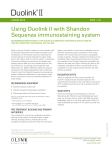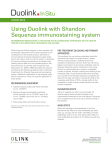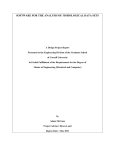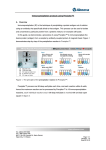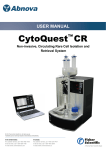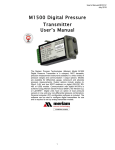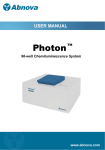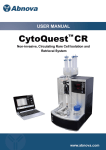Download In situ Proximity Ligation Assay protocols
Transcript
In situ Proximity Ligation Assay protocols !! PLEASE READ BEFORE USE !! The test protocol is a guideline, user need to determine their optimal experimental condition for best performance. The following protocol is modified from Duolink™ in situ PLA in situ Proximity Ligation Assay user manual, please refer to this manual for detail information. It is available to download from Olink Biosciences website (http://www.olink.com/) on Support & Downloads section. SECTION 1 – Introduction of in situ PLA Technology DuolinkTM in situ Proximity Ligation Assay (PLA) technology is capable of detecting single protein events such as protein interactions (e.g. protein dimerization) and modifications (e.g. protein phosphorylation) in tissue and cell samples prepared for microscopy. The target is detected using one or two primary antibodies depending on the application. In the case that two primary antibodies are used, they must have been raised in different species. A pair of oligonucleotide labeled secondary antibodies (PLA probes) is applied on the sample, and a signal is generated only when the two PLA probes have bound in close proximity, either to the same primary antibody or two primary antibodies that have bound to the sample in close proximity. The signal from each detected pair of PLA probes is visualized as an individual fluorescent dot. These PLA signals can be quantified (counted) and assigned to a specific subcellular location based on microscopy images. In principle, with appropriate primary antibodies, in situ PLA technology can detect any antigen with proximate epitopes at the single molecule level. SECTION 2 - Reagent & Equipment 2.1 Antibody pair for detecting phospho-protein or protein-protein interaction Abnova have two type of Ab pair products for PLA™ application, Ab pair for detecting protein phosphorylation (Catalog # format: DPxxxx) or protein-protein interaction (Catalog # format: DIxxxx). 2.2 DuolinkTM in situ PLA reagents Catalog # 90301 PLA probe 100 Mouse PLUS Catalog # 90202 PLA probe 100 Rabbit MINUS Catalog # 90103 Duolink® 100 Detection Kit 613 Catalog # 80100 Duolink® Mounting Medium 10 ml These reagents are available to purchase from Abnova or Olink Biosciences (http://www.olink.com/webshop.php). 2.3 Reagents required for fixation and antigen retrieval of the sample (according to your own protocol). 2.4 Ethanol Tel: +886-2-87511888 Fax: +886-2-87511166 9th Fl., No.108, Jhouzih St., Neihu District, Taipei City, 114 Taiwan. Page: 1/5 Revision: 1.1 2.5 Equipment needed: Fluorescence microscope equipped as follows: i. Excitation/emission filters compatible with fluorophore and nuclear stain excitation/emission. ii. Software for image acquisition and evaluation. Staining jars. Pen or mask for delimitation of reaction area (e.g. grease pen or silicon mask). Shaker. Humidity chamber (moist chamber). Freeze block for enzymes. Incubator, +37°C. Pipettes (covering the range from 1 µl to 1000 µl). Cover slips compatible with fluorescence microscopy. High purity water (sterile filtered, MilliQ® or similar) 2.6 Software for image analysis The result from a Duolink experiment is typically a number of distinct fluorescent dots (“PLA signals” or ”Blobs”) of sub-micrometer size in various locations of the studied cells. To analyze the result, any image analysis software can be used using suitable algorithms. A freeware optimized for image analysis of individual PLA signals has been developed by the Centre for Image Analysis, Uppsala University. The freeware “BlobFinder” is available for download from http://www.cb.uu.se/~amin/BlobFinder. SECTION 3 - Preparation of Reagents & samples 3.1 Reagents Primary antibodies Use Antibody Diluent stock (5x) include in the DuolinkTM in situ PLA reagents to dilute the antibody. We recommend to dilute Phospho-Ab 1:1200 (v/v) & Non-phospho-Ab 1:50 (v/v) as a starting dilutions for Ab pair detecting protein phosphorylation, or to dilute rabbit Ab 1:1200(v/v) & mouse Ab 1:50(v/v) as a starting dilutions for Ab pair detecting protein-protein interaction. However, each antibody may require some optimization in customer’s own specific experiment. DuolinkTM in situ PLA reagents Please prepare the reagent according to Duolink™ in situ PLA in situ Proximity Ligation Assay user manual. 3.2 Samples Before you start the assay protocol, the sample should have been deposited on a glass slide, sufficiently pre-treated to fit the primary antibodies with respect to fixation, retrieval and permeabilization, please see section 5.2 in Duolink™ in situ PLA in situ Proximity Ligation Assay user manual. Your reaction area must be Tel: +886-2-87511888 Fax: +886-2-87511166 9th Fl., No.108, Jhouzih St., Neihu District, Taipei City, 114 Taiwan. Page: 2/5 Revision: 1.1 delimited. You can use chamber slides or delimit your sample with e.g. a grease pen or silicon mask. 3.3 Reaction volume Use open droplet reactions. Perform the incubations without a cover slip. Perform all incubations in a pre-heated humidity chamber. Use volumes corresponding to your reaction area. Never use less than 15 µl of total reaction volume. Note: It is important that all incubations are performed in a humid environment to prevent excessive evaporation. If the sample goes dry, this will give rise to severe artifacts. Area Total reaction volume 0.2 cm2 15 µl 2 40 µl 2 cm2 80 µl 1 cm 2 120 µl 4 cm2 160 µl 6 cm2 240 µl 2 320 µl 3 cm 8 cm 10 cm2 400 µl Table 1, Suitable reaction volume for different reaction areas. SECTION 4 - Assay Procedure Before you start, your samples shall be deposited on glass slides and pre-treated with respect to fixation, retrieval and/or permeabilization. Use open droplet reactions without a cover slip and perform all incubations in a humidity chamber. The volume examples are based on 40 µl reaction volume suitable for 1 cm2. Use volumes corresponding to your reaction area, see section 5.3 and the Reaction Volume Guide. 4.1 Blocking a) Dilute the Duolink Blocking stock 1:5 in high purity water. E.g. For a 40 µl reaction take 8 µl of the 5x Blocking stock and 32 µl of high purity water. 4.2 b) Add the Blocking solution to each sample. c) Incubate the slides in a pre-heated humidity chamber for 30 min at +37°C. Primary Antibodies a) Mix and dilute primary antibodies at suitable concentration in 1x Antibody Diluent. b) Tap off the Blocking solution from the slides. Try to obtain equal residual volume for each slide as this will affect reproducibility. Tel: +886-2-87511888 Fax: +886-2-87511166 9th Fl., No.108, Jhouzih St., Neihu District, Taipei City, 114 Taiwan. Page: 3/5 Revision: 1.1 4.3 c) Do not allow the samples to dry before addition of the primary antibodies as this will cause background. d) Immediately add the primary antibody solution. e) Incubate in a humidity chamber at 4°C, overnight. PLA probes a) Mix and dilute the two PLA probes in 1x Antibody Diluent. E.g. For a 40 µl reaction take 2.7 µl of PLA probe MINUS stock, 2.7 µl of PLA probe PLUS stock and 34.6 µl of 1x Antibody Diluent. 4.4 b) Tap off the primary antibody solution from the slides. c) Wash the slides in a wash buffer (1x TBS-T) for 5 min, twice. d) Add the PLA probe solution. e) Incubate the slides in a pre-heated humidity chamber for 1 hour at +37°C. Hybridization a) Dilute the Duolink Hybridization stock 1:5 in high purity water and mix. E.g. For a 40 µl reaction take 8 µl of the 5x Hybridization stock and 32 µl of high purity water. 4.5 b) Tap off the PLA probe solution from the slides. c) Wash the slides in a wash buffer (1x TBS-T) for 5 min, twice. d) Add the Hybridization solution to each sample. e) Incubate the slides in a pre-heated humidity chamber for 15 min at +37°C. Ligation a) Dilute the Duolink Ligation stock 1:5 in high purity water and mix. b) Wait to add the Ligase until immediately before addition to the samples. Take the addition of Ligase into account when calculating the amount of water added. E.g. For a 40 µl reaction take 8 µl of the 5x Ligation stock and 31 µl of high purity water. c) Tap off the Hybridization solution from the slides. d) Wash the slides with 1x TBS-T for 1 min under gentle agitation. e) Add Duolink Ligase to the Ligation solution from step a) at a 1:40 dilution and vortex. E.g. For a 40 µl reaction add 1µl of Ligase to 39 µl of Ligation solution. 4.6 f) Add the Ligation solution to each sample. g) Incubate the slides in a pre-heated humidity chamber for 15 min at +37°C. Amplification a) Dilute the Duolink Amplification stock 1:5 in high purity water and mix. b) Wait to add the Polymerase until immediately before addition to the sample. Take the addition of Polymerase into account when calculating the amount of water added. E.g. For a 40 µl reaction take 8 µl of the 5x Amplification stock and 31.5 µl of high purity water. c) Tap off the Ligation solution from the slides. Tel: +886-2-87511888 Fax: +886-2-87511166 9th Fl., No.108, Jhouzih St., Neihu District, Taipei City, 114 Taiwan. Page: 4/5 Revision: 1.1 d) Wash the slides with 1x TBS-T for 2 x 2 min under gentle agitation. Tap off all wash solution after the last washing. e) Add Duolink Polymerase to the Amplification solution from step a) at a 1:80 dilution and vortex. E.g. For a 40 µl reaction add 0.5 µl of Polymerase to 39.5 µl of Amplification solution. 4.7 f) Add the Amplification solution to each sample. g) Incubate the slides in a pre-heated humidity chamber for 90 min at +37°C. Detection Please note! Light sensitive reagents – keep protected from light. a) Dilute the Duolink Detection stock 1:5 in high purity water and mix. E.g. For a 40 µl reaction take 8 µl of the 5x Detection stock and 32 µl of high purity water. 4.8 b) Tap off the Amplification solution from the slides. c) Wash the slides with 1x TBS-T for 2 x 2 min under gentle agitation. d) Add the Detection solution to each sample. e) Incubate the slides in a pre-heated humidity chamber for 30 min at +37°C. Final wash step Please note! Light sensitive reagents. Wash and dry the slides protected from light: 4.9 a) 2x SSC for 2 min. b) 1x SSC for 2 min c) 0.2x SSC for 2 min. d) 0.02x SSC for 2 min. e) 70% EtOH for 1 min. f) Let the slides dry. Preparation for imaging Use a minimal volume of Duolink Mounting Medium (Art no. 80100) and apply a cover slip on top of your sample. Preferably add the mounting media to the cover slip and then gently slip over the sample slide to ensure no air bubbles get caught under the cover slip. Analyze in a fluorescence microscope as soon as possible. 4.10 Image acquisition and analysis Please refer to Duolink™ in situ PLA in situ Proximity Ligation Assay user manual, for image acquisition and analysis detail. Tel: +886-2-87511888 Fax: +886-2-87511166 9th Fl., No.108, Jhouzih St., Neihu District, Taipei City, 114 Taiwan. Page: 5/5 Revision: 1.1





